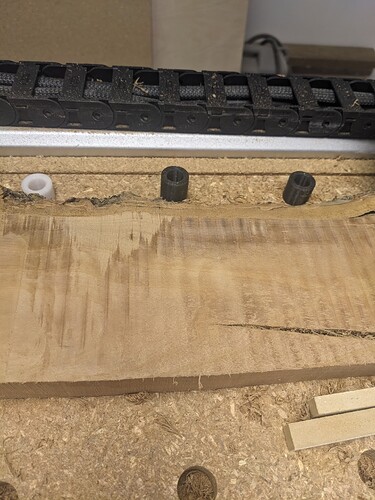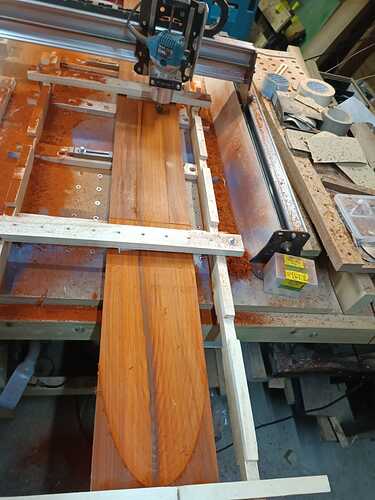I have a chunk of cherry that is maybe 20 years old and has been gathering dust. It’s a plank maybe 2 feet long and less than a foot wide. It was cut from a round log on a bandsaw … freehand. In other words really rough looking. I decided to try and make it semi usable by surfacing it. I have a 22mm diameter cutter with 4 carbide inserts that, although previously used, should be sharp.
I tried 17000 RPM and 20000 RPM with a cut depth of 1 mm and a step-over of 85% to get it done fairly quickly. I had a feed rate of 2500 mm/min on an Altmill. At both speeds, the cut surface turned out charred.
Since this is my first go at doing anything with cherry, I am curious if this is normal. Does cherry require some special setup as far as speed/feed/whatever is concerned?
After I had one side surfaced, I ran the second side through a planer and it came out without any charring whatsoever. I flipped it over to the charred side, ran it through the planer and it came out fine.
@Jens Cherry can be finicky. Since you had good results with your planer, it would seem that there was nothing inherently wonky (technical talk) with your slab. If it were me, I would keep the rpm at your lower end but speed up the feed rate. Also, even though you have said the carbides were sharp, if you have more to do, it would not hurt to rotate them. At the very least, check to ensure that they are not gummed up with pitch from previous jobs.
Thanks, I will give a faster feed rate a try. I am always afraid of going too fast and breaking stuff. Even at 2500 mm/min, which I had previously used on soft wood, I was concerned that Cherry might be too much of a load. I will have a go at things with lower RPM, faster feed and verify that the carbide cutters are clean.
It might be wishful thinking but there is a possibility that my first (lower rpm) pass wasn’t quite as charred … this would confirm your recommendations.
Not sure which planer you have but the Dewalt DW735 had a cutter speed of 10000 rpm. Not an apple to oranges comparison considering the cutter head diameter and angle of the cutters but it might give you an idea of the speed to use.
I flattened a 30" endgrain cutting board that was cherry and walnut. I too was having bad burning issues. I slowed the spindle way down and increased feed rate…worked like a champ. I cannot remember what speeds I used though.
I have done another test at 10000 rpm and 4500 (holy crap) mm/min. . The tips of the carbide cutters had obviously gotten quite toasty from my earlier attempt. There are no charr marks as such. The wood discolours a bit and the level of colourization doesn’t seem to change any more (I varied the feed speed). The picture attached is with a feed-over of 20% (that didn’t change the outcome).
Note that the surface just below and to the right of the white post is the surface the bandsaw left.
It definitively is a feed/speed issue!
Well it would appear that the conditions are not favourable for surfacing Cherry on the mill:
- twisted board
- highly irregular surfaces on both sides
- edges on the work piece are highly irregular and uneven (live edge)
- a clamping system that isn’t ideal, especially if I try holding the work piece on the edges
- a Jointer right next to the mill
I eventually ran at 7000 rpm and 5000 mm/min and there was no discolouration at all … at least for the little bit before the clamping system gave way. There was quite a bit of load on the spindle based on the drop in rpm (I had about a 50% engagement of the surfacing bit with 1 mm depth of cut) so I should be using a smaller surfacing cutter but I am short on one of those. I could make sure that the first pass along the edge of the work piece doesn’t take that wide a cut and reduce step-over. I suppose I could also reduce depth of cut… I could also order a 2.2 kW spindle but that would possibly be a bit of a Tim Taylor solution /insert appropriate grunts here/ … besides, the chunk of Cherry would still go flying.
That leaves me with reason 5 in the list above … a lot quicker and a perfect finish.
The only down side of using the jointer - I don’t actually NEED the cherry for anything and just wanted a reason to play with the mill.
Oh well, it was an interesting learning experience ![]()
Hi Jens,
I have read this topic with interest. I too have encountered the problems that comes with surfacing difficult woods. Padouck doesn’t like fast spinning surfacing bits either, but it’s manageable and wont char if I enlarge the surfacing toolpath beyond the stock size to keep directional changes away from the material.
My most difficult wood is Azobé. It discolours when I look at it the wrong way and I have not mannaged to use my 22mm bit and not have it go brown up. I must confess, I fear to dile down the rpm below 15k. It doesn’t sound right.
I do however make key labels out of the same material and surface around the shape of the label with a 6mm35 downcutter. No burning will happen, even at an rpm of 19k.
So, your theory to go smaller seems sound.
About clamping a rough piece that needs it’s complete surface done, and not having or wanting to use a planer, the mask tape and glue (not a fan) wont work. The tape wont hold on the rough sides, risking dissaster. Side clamping, tiled surfacing or calculating in small wast strips at the end of the stock are the only viable options I have been able to use.
You were right to dive into the cnc surfacing challenge. It reveals a lot on the wood you are about to attack, right before the beginning of a job. A last chance to reconsider the aggressive nature of the toolpaths generated.
I love how you challange yourself, even when you have a way to accomplish the job with a mkre dedicated tool for the job.
Kuddo’s
Great to hear about your experiences. I have never seen Padouck or Azobe … heck, Maple is considered ‘exotic’ to me.
I used side clamping in my tests but must admit that my tests were mostly with a single cam clamp (and a bunch of stationary posts) so it is not surprising that things didn’t go as planned when the chip load increased (faster feed, slower rpm). The boards being twisted made it impossible on one board to hold it at all. I didn’t want to go the route of screwing anything down. I do not recognize the ‘tiled surfacing’ option.
Great tip to keep directional change away from the material. I hadn’t thought about that but it makes a lot of sense for difficult materials.
I was crossing my fingers and toes when I ran any tests below 10k rpm or 3500 mm/min. I agree that it doesn’t feel or sound ‘right’ …
Thanks for the Kudos!
Padouck is an awesome hardwood that has a destinct deep red colour. Azobé is used around here for water managenent projects. It has a lifespan of 30+ years without protection. It has rather boring and dark look that does not make it a popular furnature wood.
Signs and inlays however pop like mad, using it. When drying, it’s a bad wood for it needs to stay moist to keep straight. After sealing (laquer or other surface sealing substance) the wood, that problem is gone, but that limits the projects you would want this wood to come close to.
In this picture I am tiling a surface job on padouck piece. Clamp the stock down and surface a tile between the clampings, shift the piece and surface the next tile.
It takes time, but overall it’s reasonable accurate.
You can see a slight discoloration in the parts that have been surfaced, but that’ll sand out.
Poplar and walnut are hard to come by down here. Cherry isn’t an option. It’s like gold.
Take TWO inserts out and use a 40-45% step over and only 0.025" cut depth. With two less inserts you’ll have a lot less heat transfer or rubbing on the surface.
Way too fast on spindle. Run large diameter tools as slow as possible. 17k = around 3800 sfm. 9k @ 100 ipm should give good result.
Rpm is for the spindle, the tip speed on a 22mm(7/8") surface bit tip speed will be a little more than 3x that. I use a 1.25" bit. You’ll find that starting at low RPM is better. 10K+ is more for engraving and V bits.
Feed rate’s needs to be as fast as you can go. On the AltMill you can use the bits rated Feed rate and then manually adjust while cutting.
When you dial it in, after the cut the bit should only be slightly warm to the touch. If it’s hot, speed it up - or sharpen it.
Your stepover of 85% is way high for a surface bit, you’re not mowing a lawn. Try 40 to 45% for a much cleaner cut. Also, if you’re using a raster cut, make sure the turn around happens past the edge of the wood.
I know I am late responding to this but when you posted this, I was just getting my machine setup. A couple months in and I ran into a similar issue with sugar maple (aka rock maple). It is quite hard and it also has a high sugar content which makes it very prone to burning. I did not have good luck with the 2 FL 22 mm bit from sienci labs (got dull too soon, never gave a great finish and loved to leave burn marks). I then bought a 1 3/8” 2+2 fly cutter with 12mm inserts from binstack on Amazon. At 18000 rpm and 4000 mm/m and 50% stepover, I am getting a finish like glass that doesn’t even need to be sanded. Absolutely amazing…

